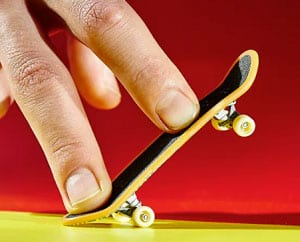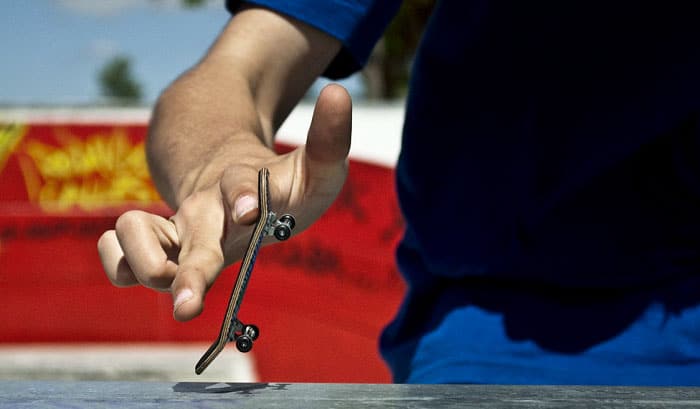Every trick done on a skateboard or fingerboard is fun and worth the practice. And with so many stunts and skills to learn, sometimes, choosing the best one to start with gets overwhelming. But that’s pretty normal.
Our mindset as skaters and fingerboard players should not only stay within the boundaries of mastering a trick or two. So, we have here a finger skateboard tricks list for you to learn in order to increase your proficiency with fingerboards.
Here, we will not only practice each trick independently. You may find some skills that are transferable from one stunt to another.
Table of Contents
Fingerboard Tricks List to Try
In this tech deck tricks list, we will go through various tricks with different difficulty levels for beginners and advanced users. That way, we’ll see what to prioritize and assess the most efficient game plan to master all these. Note that we’re using our right hand here.
Let’s begin with some easy fingerboard tricks.
1. Ollie
Check skateboard or fingerboard tutorials on air tricks, and most of them will require doing an ollie because that is where most, if not everything, starts. And such a concept also applies to fingerboards.
We only need a neat space for this trick. So, begin by putting your index finger behind the front truck bolts and your middle finger on the tail.
Snap the fingerboard’s tail as you slide your index to the nose. Push the board into air and have it horizontally positioned. Afterward, land the fingerboard on its wheels.
Here are other ollie on a tech deck variants that only differ depending on how much the board spins.
- 180 ollie
- 360 ollie
- 540 ollie
- 720 ollie
- 900 ollie
- 1080 ollie
2. Kickflip
Kickflips are the trick you should learn along with ollies.
To pull them off, we don’t simply press the fingerboard down after popping it in the air for an ollie. Instead, once the fingerboard is up after your snap, we slide our index to the nose pocket closer to us.
Then, press it moderately to make the deck spin on its length. While the board is in the air, use your index and middle finger to find its stepping surface. Then, land the fingerboard back down.
Besides the regular kickflip on a tech deck, you can also change up the trick with the following.
- Double kickflip
- Triple kickflip
- Varial kickflip
- Late flip
3. Shuvit
Shuvits are tricks on a tech deck you can do without moving the board too high. It’s a simple shift of the nose to a tail position.
The goal of this trick is to make the fingerboard rotate 180°. So, while still in an ollie position, pull the deck’s tail inward.
As soon as you pull the deck’s tail, lift your hand.
Such a move will make the nose spin. And once the board completes its 180° turn, stop it from spinning by placing your fingers back on it.
A shove-it or shuvit also has other related styles. Here are some of them.
- Pop shove-it
- 360 shove-it
- Shove-it underflip
- Shove-it rewind
4. Nollie
Nollies are fingerboard tricks ollie fans perform by doing the opposite of what’s required for an ollie.
Start by placing your index finger on the fingerboard’s nose and your middle finger slightly in front of the rear truck bolts.
To do the nollie, roll your skateboard forward following the nose’s direction. As soon as it gains speed, pop the fingerboard using your index finger. Yes, you are going to snap the deck’s nose.
Your wrist may feel a bit awkward at first while shifting the deck’s tail up.
So, once the fingerboard makes around a 90° turn, press the tail down to level with the nose. Land the board with both fingers.
Are You Searching for Something More Thrilling?
You probably noticed that the first five tricks we discussed connect through an ollie and are part of the basic skateboard tricks list. And that explains why ollie-ing is a fundamental skill for fingerboards and skateboards.
Now, let’s see a few hard fingerboard tricks that will make you shed some more sweat.
1. Heelflip
A heelflip is the exact opposite of a kickflip. In this trick, we let the fingerboard spin away from us.
Begin with the ollie position, index behind the front truck bolt, and middle finger on the tail. Push the fingerboard toward the nose’s direction and pop its tail.
As soon as the board takes off, press the pocket of the deck farther from you. Doing so will make the board turn.
And once the fingerboard completes its turn, locate its stepping surface using your fingers. Land the board on its wheels
2. Impossible
The trick’s name being “impossible” doesn’t mean you can’t do it. It is a challenging skill to master because it requires more precision maneuvering the fingerboard mid-air. Here’s how to perform the skill.
So, begin with your standard finger position. Roll the board forward and snap the tail to let the fingerboard take off.
But as soon as the finger skateboard lifts, pull your index finger back. Doing such a move will make the deck’s nose go up and spin to the back.
The fingerboard will make a 360° turn on its nose and tail. Once it completes its rotation, put your index finger above the stepping surface. Land the board like the previous tricks.
The following tricks also come from an Impossible.
- Dustin impossible
- Double impossible
- Flipossible
3. Hardflip
Another trick that seems unachievable is the hardflip. Its only difference from a kickflip is that a pop shuvit also comes along.
From the standard fingerboard position, push the board forward as you snap its tail.
Like doing a kickflip, move your index finger to the front pocket closer to you. Here, the fingerboard shifts like in a shuvit. Also, it spins on its side similar to a kickflip.
Once the board completes its spin and rotation, plot your fingers above it and land on its wheels.
If you want to challenge yourself with added difficulty, here are more hardflip styles you may want to try.
- Hardflip rewind
- Double hardflip
4. 360
Perhaps, this is one of the most challenging tricks to execute on a fingerboard. It’s close to the previous trick, only that we pull the tail closer to us this time.
We still start with the standard finger skating position and popping the deck’s tail.
As soon as the fingerboard takes off, scoop the board’s tail closer to you while extending your index to push the nose to make a turn. These movements should be snappy enough to let the deck rotate like a varial kickflip and shuvit combined.
Place your finger back on the fingerboard’s stepping surface as you stop its rotations and land it down.
Frequently Asked Questions
What is the hardest fingerboard trick?
Preference could still be relevant when ranking fingerboard tricks from easiest to hardest. Similarly, it could also be challenging to identify which among these skills belong to intermediate fingerboard tricks.
But one of the most challenging tricks you can perform is a 360. Here are two more from a tech decks tricks tutorial.
- Heelflip – Opposite of a kickflip that requires flicking the board away from you.
- Laser flip – A combination of a shuvit and a heelflip with a full 360° rotation.
How many fingerboard tricks are there?
There are not two or ten fingerboard tricks we can do. I came across a platform sharing how 120 finger skating tricks are possible.
Most of these tricks are variants of their original style. Innovation and creativity came, and these original stunts got more changes.
Conclusion
Fingerboards are miniature skateboards. But that does not mean we can’t enjoy them the way we do with their bigger counterparts. Tricks skaters do on 8-inch boards are no less than possible with a fingerboard.
We should understand each step of the tricks and observe their progression. What’s better today is there are already many video tutorials to help you. And with this finger skateboard tricks list, knowing what to practice next will no longer be difficult.
So, grab your fingerboard, and it’s time to check all these tricks on the list.

Hi, I am Charles Harris. I opened this site to write as much as I can about my biggest passion – skateboarding!
I started as a clumsy yet passionate rookie 10 years ago to now a still passionate yet much better skateboarder! But I have to tell you, the whole journey has always been fun and rewarding, indeed not without hardship.










